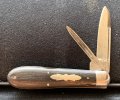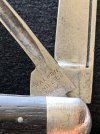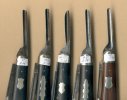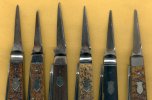A grandaddy barlow (5 inches in length closed). As far as I can tell the tang stamp is EDWARD / FURNESS / ENGLAND. It has been my understanding that there were no Sheffield barlows of this pattern from this era. No idea if the knife is legitimate or not. It is very tight with good snap. The knife has integral bolsters. I have provided a good number of photos so the experts may have a chance to evaluate it.
View attachment 1811112View attachment 1811111View attachment 1811114View attachment 1811113View attachment 1811123View attachment 1811124View attachment 1811122
That's a great example and I think it's absolutely legitimate, but very unusual for three reasons.
First, as I mentioned in the podcast, I hadn't remembered seeing a Daddy (or Grand Daddy) Barlow that was produced in England. But facts always trump memory.

I did some hard digging and came up with one such large example from Johnathon Crookes circa 1920, so they did in fact exist, but are still quite rare. (picture enclosed)
The second odd trait on your model is the clip blade. While clip blades are found on some Russell Barlow's and are also seen on some other brands, clip blades are definitely not common on English Barlow knives.
But again, the catalog illustration from Crookes shows a Daddy Barlow with a clip blade.
The final oddity on your model is the blade tang stamp. All of the Furness Barlow knives that I have seen have the blade stamp lengthwise on the blade and not on the tang itself.
But the Crookes model shows a tang stamp and all the Wostenholm Barlow models also had blade tang stamps.
So, I would bet that your knife is correct and probably one of the last from E. Furness dating to the early 1900s.
It would seem that your knife and the Crookes model shown were riding off the popularity of the large Russell Barlow's with clip blades in the early 20th century.
Good score my friend.
View attachment 1811820




